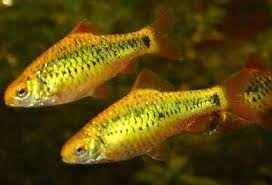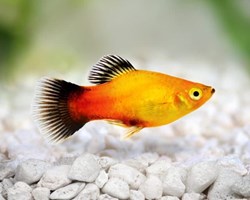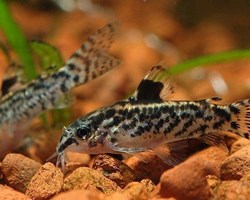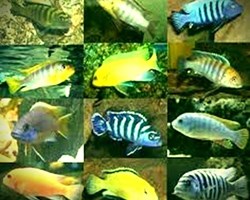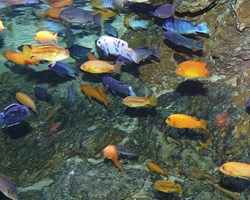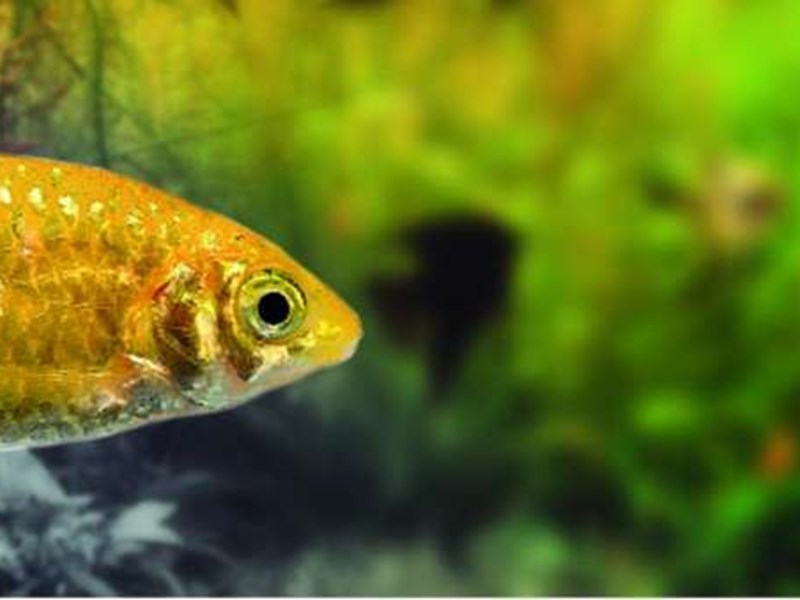
DESCRIPTION OF THE GOLDEN BARB OR PUNTIUS SEMIFASCIOLATUS:
The Puntius semifasciolatus inhabits Asia, specifically southwestern China in the Red River including the Hainan, it is also found in the Mekong, in the rapid and temperate waters of the rivers near Canton and Hong Kong. They have also been introduced in Singapore and Hawaii.
It is a species of fish in the family Cyprinidae in the order Cypriniformes.
It is a peaceful fish that can coexist with all kinds of small species that it will not bother, unless it is because of its lively and active character.
Although he usually alternates periods of intense activity with others in which he is much calmer.
It is a cyprinid with a wide and laterally compressed body.
Its size in adult stage the female is 7cms. approximately and the male of 6 cm.
It presents the widest body in the central part and compressed on the sides.
Its fins are soft and rounded, highlighting the flow that usually has a "V" shaped termination.
It doesn't have barbels.
Its coloration presents Yellows, females usually have black spots, males have fewer spots or do not have them at all, the fins are orange, in females with a stronger tone than in males.
Its habitat is found in fast flowing Asian rivers.
Native to the Red River Basin in China, Taiwan, and Vietnam, this fish is known worldwide as the "golden barbel."
It is a very popular fish in the aquarium trade.
Due to damage to native habitat in Taiwan, populations of species there are at risk.
The golden barbel is widely sold in the aquarium trade and is bred in captivity in many places.
Scientific name: Puntius Semifasciolatus.
Synonym: Barbus aureus, Barbus hainani, Barbus semifasciolatus, Capoeta semifasciolata, Puntius semifasciolata.
Common Name: China Barb, Chinese Barb, Chinese Half-Striped Barb, Gold Barb, Green Barb, Half Banded Barb, Half-Stripes Barb, Schubert's Barb, Six-Banded Barbed Barb.
Family: Cyprinidae.
Origin: China Red River Basin, Taiwan, Vietnam.
Adult size: 3 inches (7.5 cm).
Social: Peaceful schooling fish.
Shelf life: 5 years.
Tank level: Down, middle dweller.
Minimum aquarium size: 20 gallons.
Golden barbels are native to a fairly large area of Asia, from the Red River basin in VietNam and southern China to Fujian (further north).
Golden barbels are also found in the Mekong basin in northern Laos and in southern China; these fish are likely to have been intentionally introduced to these areas, as well as Hong Kong, Taiwan, Hawaii, and Uruguay.
The natural color of this barbel is green, but that color is rarely seen in the aquarium trade due to the popularity of the golden barbel.
Virtually all specimens sold today are captive bred, and a few other color variations have subsequently emerged, including an albino variant.
Reaching an adult size of three inches, the golden bard has a steeply sloping back and short barbels set in the mouth.
Males will be metallic gold or golden green, with a lighter belly that turns red when ready to spawn.
The females will be much duller in color, and are generally larger than the males.
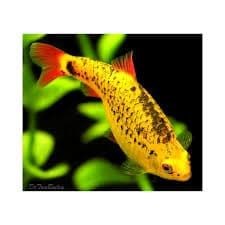
AQUARIUM CARE FOR THE GOLDEN BARB:
Easy.
pH: 6.0–8.0.
Hardness: up to 10 dGH.
Temperature: 64–75 degrees Fahrenheit (18–24 degrees Celsius).
Gold barbels are exotic fish that are quite hardy and undemanding to water conditions and habitat.
They tolerate a wide range of water conditions, making them adaptable to a variety of habitats. A stream would be welcomed by this species, as they originate from free-flowing streams and rivers.
They should be provided with a good sized open space to swim in, along with plants. put up decorations to provide some places to hide.
Use a fine substrate, preferably a darker color to show the colors of the fish.
Because this fish does well in cooler water, it can be kept in an unheated aquarium.
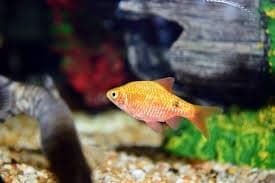
THE NUTRITION OF THE GOLDEN BARB:
In its natural habitat, this species lives on a diet of insects and larvae, as well as worms, vegetation.
It is an omnivorous fish, eating anything available.
To maintain optimal health, a varied diet is advisable.
Flake, pellet, freeze-dried and frozen foods will be readily accepted. When possible, include live foods, such as insects, brine shrimp, and worms of all kinds.
Fresh vegetables are an excellent complement and will be readily accepted.
Try to vary their diet by occasionally offering live food such as daphnia, brine shrimp, mosquito larvae, etc.
He also likes food of plant origin, so we must offer him zucchini, cucumber, spinach, chard and lettuce.
BEHAVIOR AND SOCIABILITY OF THE GOLDEN BARB:
They are lively and peaceful fish.
They are not fish that swim in schools but they need the company of others, so they should be kept in groups of 6 or more individuals as they can be shy if they are in smaller numbers.
Normally their swimming level is in the middle and lower zone of the aquarium.
It is ideal for community aquariums with species with an Asian biotope.
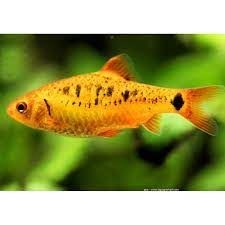
REPRODUCTION OF THE GOLDEN BARB:
It can be achieved in a 30 liter aquarium with tall leafy stem plants with a temperature of 25°C.
It will be necessary to put a protective mesh about 6 cm. from the bottom with an aerator or sponge filter, then we place the couple below the mesh, as it is shallow, it will be easier for the male to press the female to expel the eggs.
Once they have finished laying, we remove the parents, since otherwise they will eat their own eggs.
In approximately 3 days the fry are born that will feed on their yolk sac, when they swim by themselves we will have to feed them with recently hatched brine shrimp for 3 weeks.
Gold barbels are relatively easy fish to breed, but as with breeding any species, a separate breeding tank is recommended. The aquarium should be well planted with fine-leaved plants such as Java Moss.
Make sure there are plenty of hiding places for the female, as the male can be quite aggressive during the spawning process. Lighting should be dim and water should be soft at about 8 dGH and pH between 6 and 7.
Use a sponge filter with a very smooth flow.
Spawning normally occurs in the early morning around sunrise.
The males will begin to surround the female, nudging her to position her near the area she has selected for spawning.
The female will release one hundred and two hundred eggs, which will then be fertilized by the male.
The adults eat the eggs readily, so as soon as the eggs have been fertilized, the adults should be removed from the aquarium.
The pale yellow eggs will hatch in about 48 hours and the fry will be free-swimming in a few days.
The fry (baby fish) will feed on fine feed and newly hatched brine shrimp.
Both the eggs and the fry are quite sensitive to light, so keep the aquarium as dark as possible until the fry are several weeks old.
